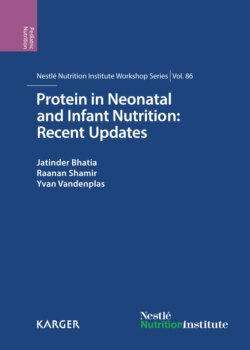Читать книгу Protein in Neonatal and Infant Nutrition: Recent Updates - Группа авторов - Страница 27
На сайте Литреса книга снята с продажи.
Hydrolyzed Formulas
ОглавлениеMany food allergens are stable and resistant to digestion by gastrointestinal enzymes or are digested into high molecular weight (MW) peptides which retain the IgE binding and T-cell-stimulating properties [7]. The molecular basis of alterations in allergenicity is the inactivation or destruction of epitopes. However, methods of CM processing should be carefully selected because they may even produce new epitopes (neotopes) or access hidden epitopes by denaturation of the native allergen (cryptotopes) [7].
Hydrolyzed formulas (HFs) differ according to the method, the timing and the degree of hydrolysis (i.e. intact protein molecules are broken down into peptides of various MW which have less allergenicity), the protein source (Cas, whey, rice or soy) and other nutritional components. The method of hydrolysis is critical for different allergens as heating denatures conformational epitopes (such as the ones of Cas and whey proteins), whilst glycation (nonenzymatic glycosylation) and lactic acid fermentation reduce allergenicity of α-Lac and β-Lg, specific enzymes act on sequential epitopes (from β-Lg), and ultrafiltration eliminates large proteins (such as β-Lg; table 1) [7]. Milk proteins in HFs are hydrolyzed using both specific industrial proteases, such as alcalase, pronase and papain, and gastrointestinal digestive enzymes, such as pepsin, trypsin and chymotrypsin, resulting in allergenic or bioactive peptides which can act differently from the intact native ones. The heating of proteins in the presence of reducing sugars produces the so-called Maillard reaction or glycation, which modifies milk proteins, their structure, aggregation and allergenic effect in different ways, which depend on the specific combination of proteins, sugars and temperature [7]. Cas and α-Lac are more heat stable than the whey proteins β-Lg and BSA. Heating milk at 120°C for 15 min did not alter the antigenicity of bovine Cas, but recognition of β-Lg by IgE was reduced by nearly 70% at 75°C whilst BSA and immunoglobulins lost their antigenicity at 70-100°C [9]. This could explain, at least partially, why some CMA patients are more tolerant to boiled milk than to raw milk. Processing at high temperatures (baking) further reduces the allergenicity of many food proteins, most likely by altering the conformation structure of heat-labile proteins and consequently destroying their allergenic epitopes [10]. Microwave treatment (at 200 W for 3 min) increases hydrolysis of β-Lg and bovine whey proteins in comparison with conventional heating and the same proteolytic treatment [11]. High pressure also induces structural changes in (whey) milk proteins, such as denaturation, and enhances accessibility of potentially immunogenic hydrophobic regions to the enzymes and formation of aggregates, which may affect and reduce the allergenic potential of CMPs [12].
Table 1. Effect of different methods hydrolysis on milk proteins
Proteolytic enzymes are even produced during fermentation by certain lactic acid bacteria that fragment epitopes and reduce allergenicity of both β-Lg and Cas [13-15].
